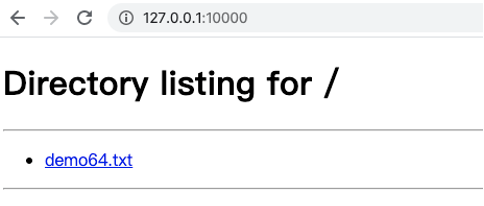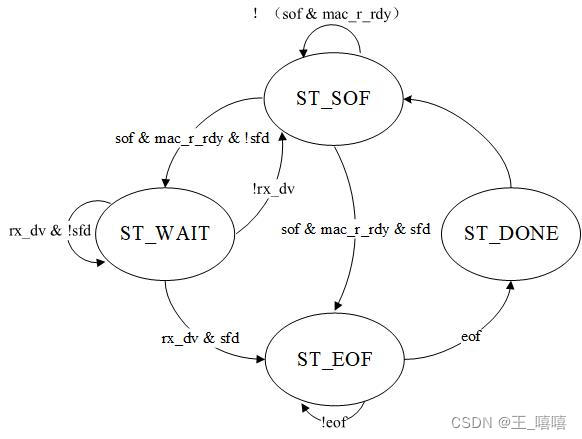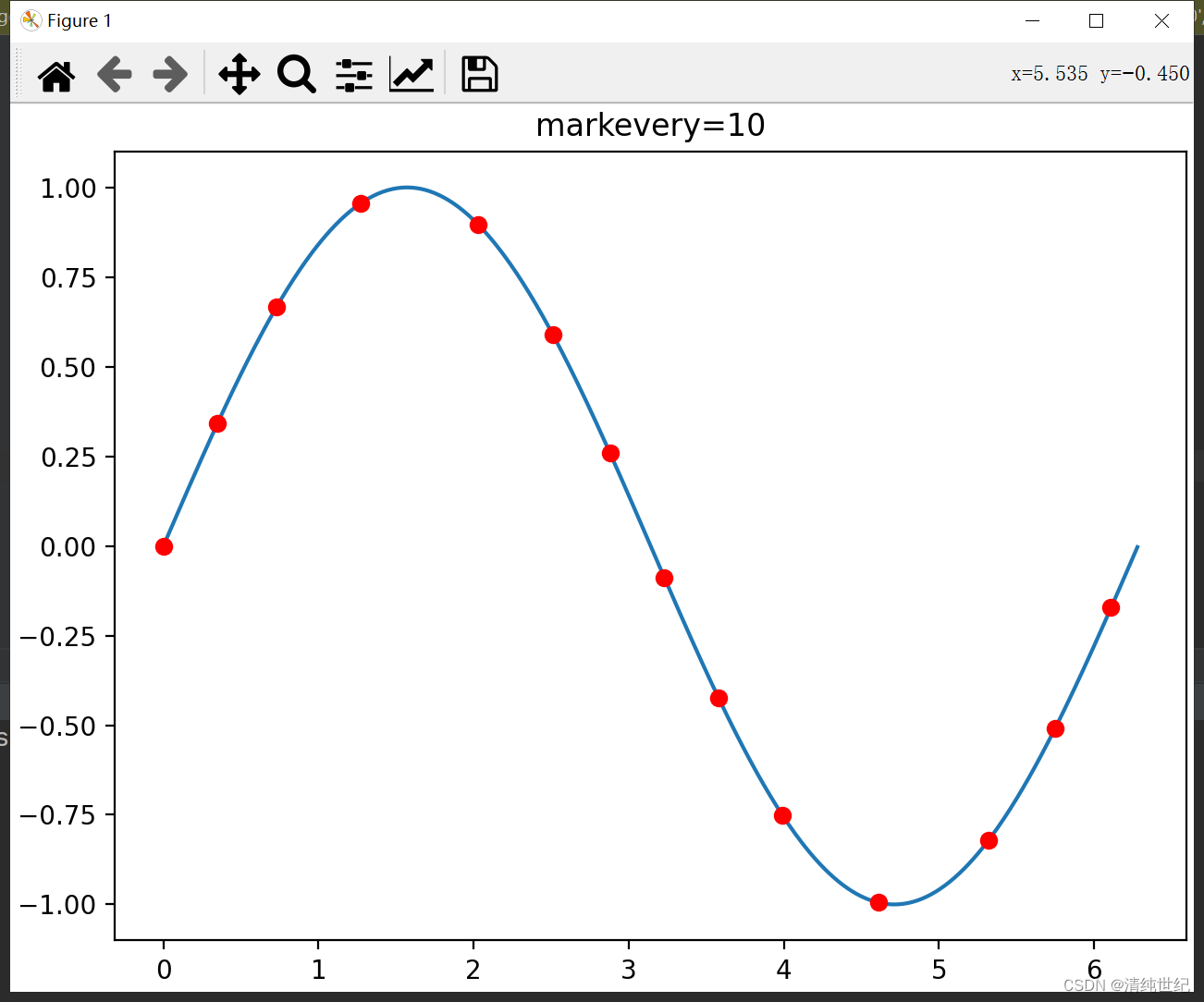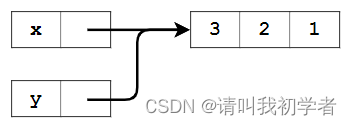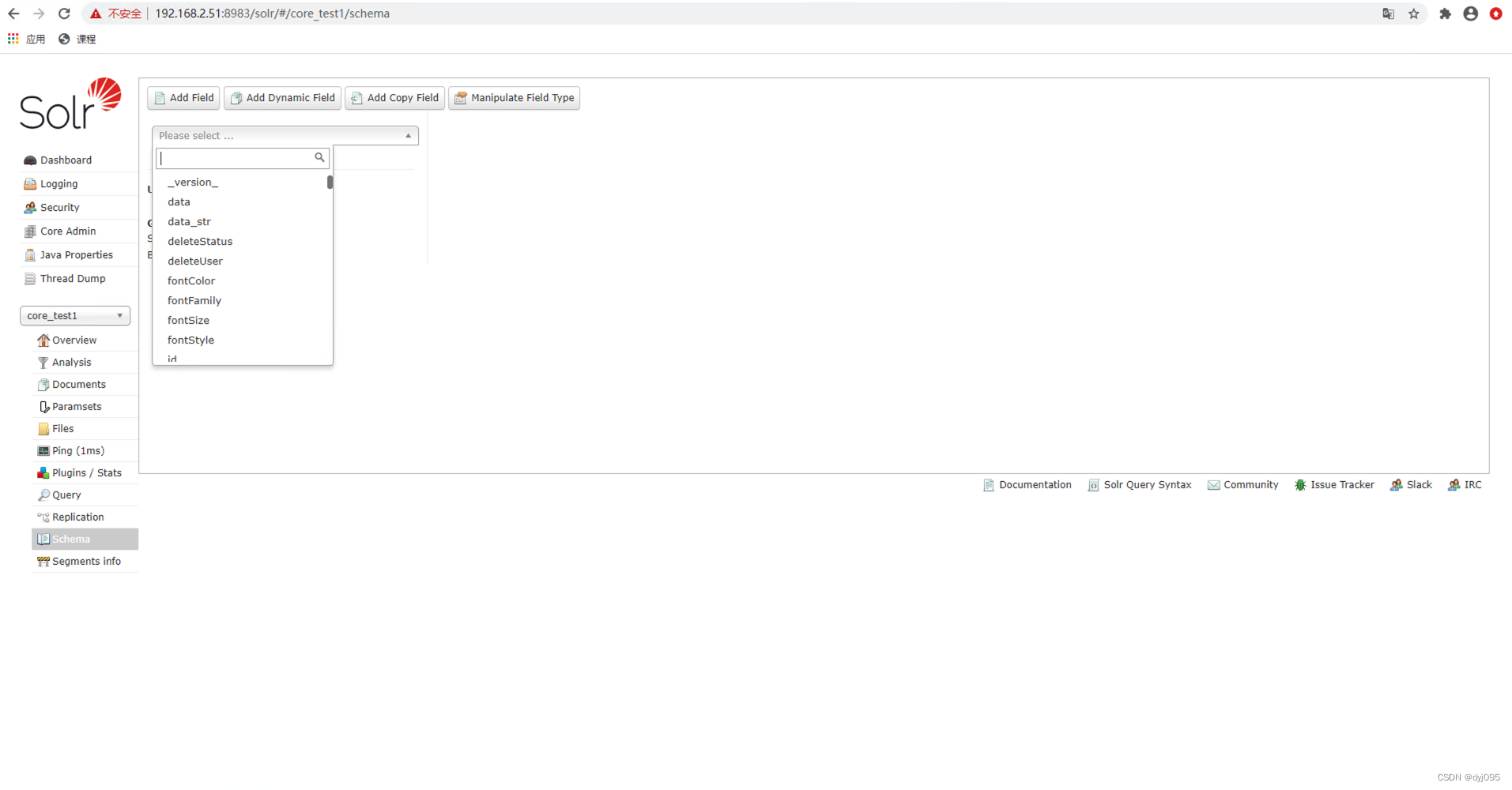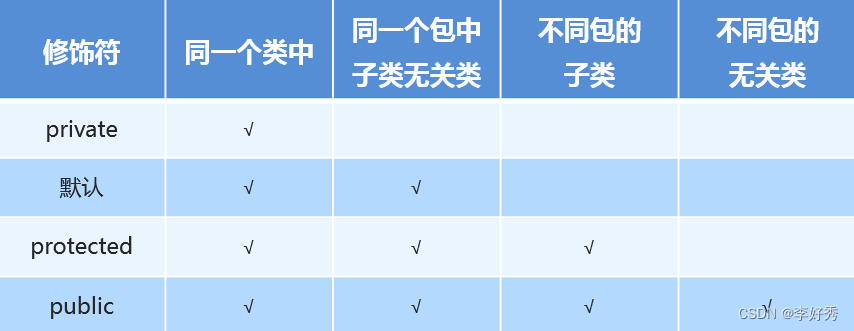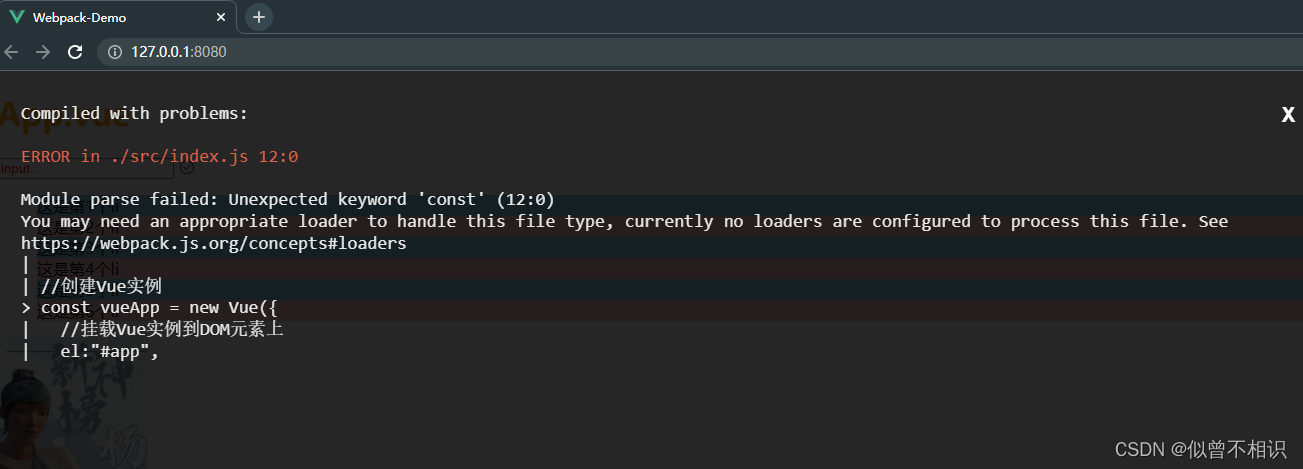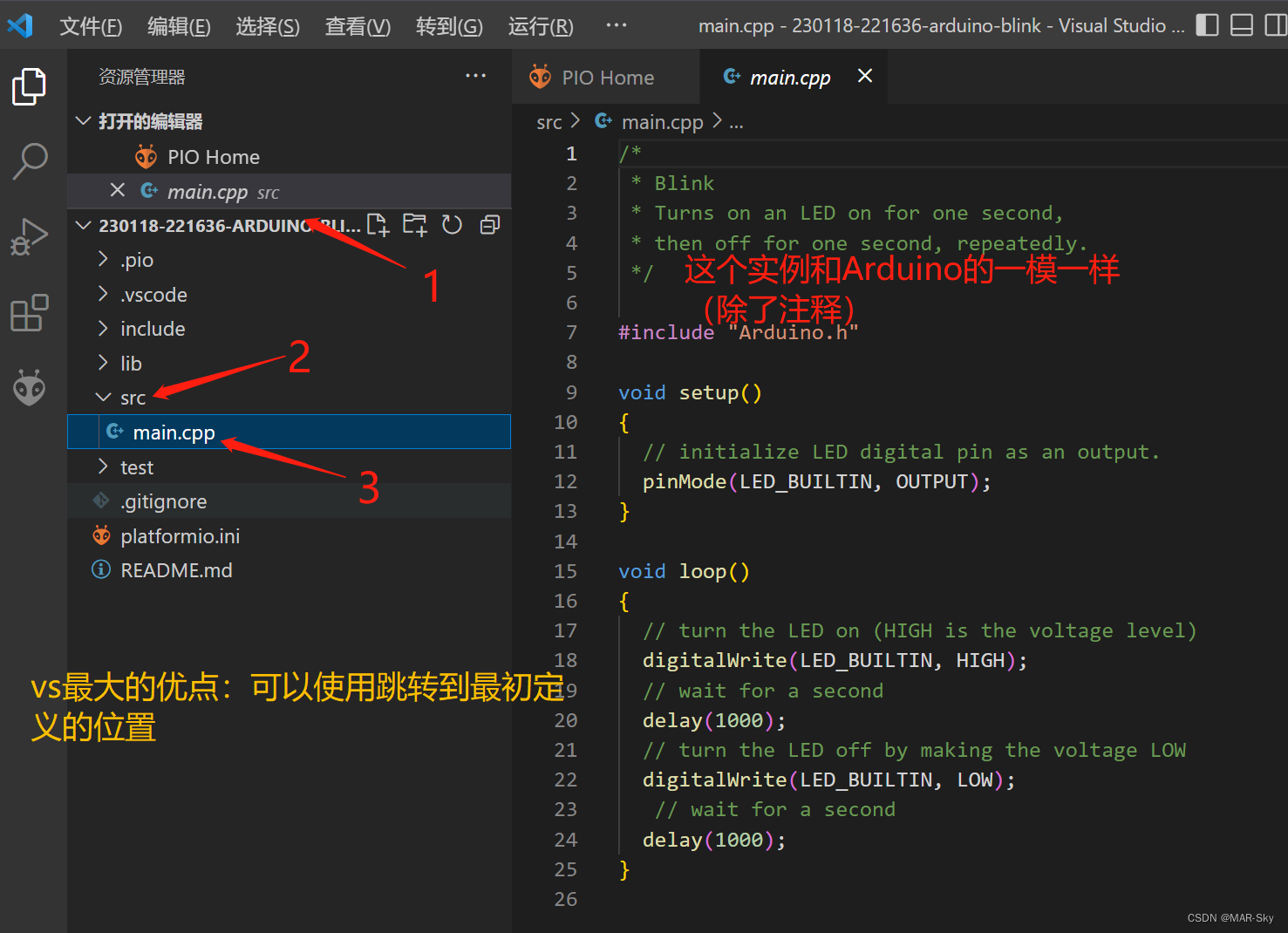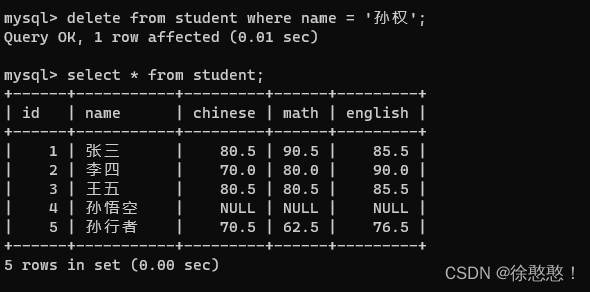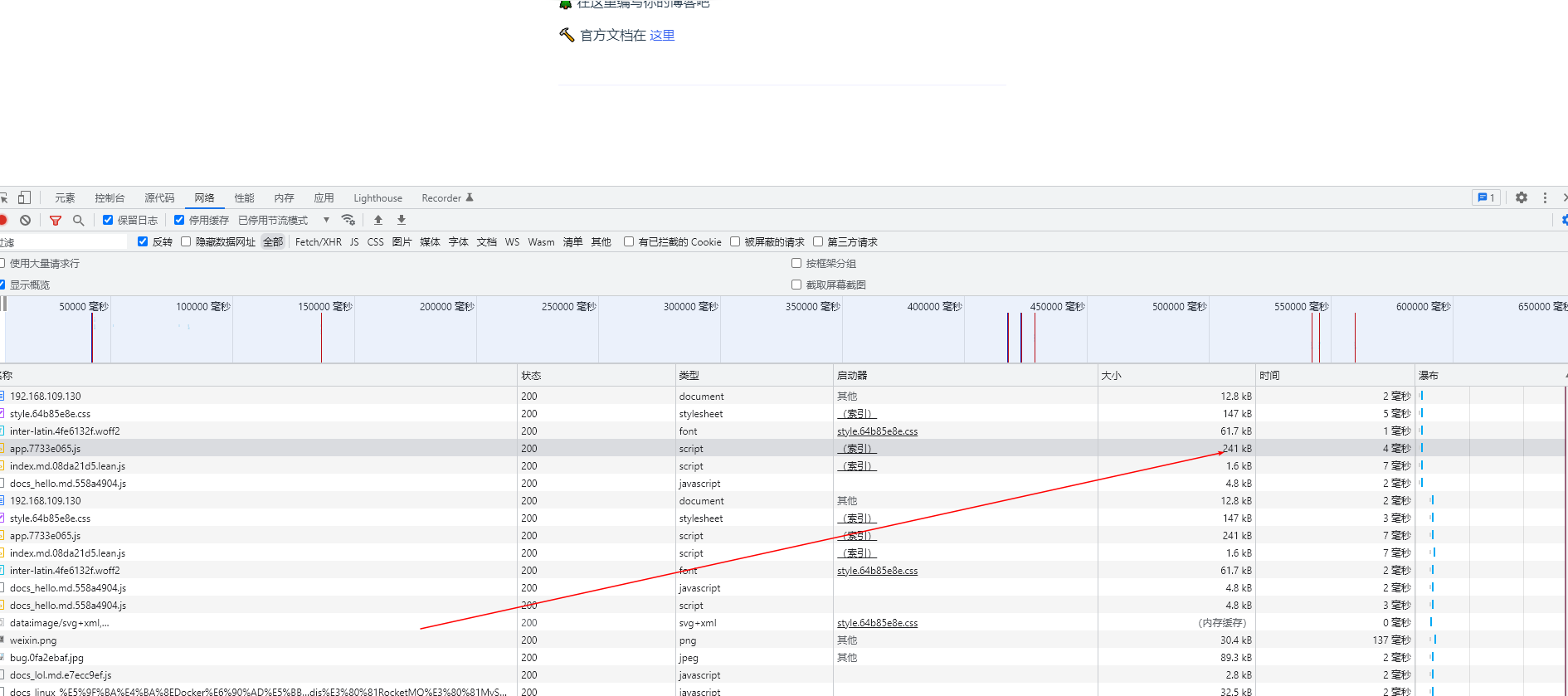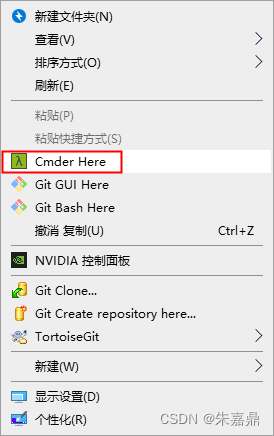1.链表
1.1链表的概念及结构
概念:链表是一种物理存储结构上非连续、非顺序的存储结构,数据元素的逻辑顺序是通过链表中的指针链接次序实现的 。
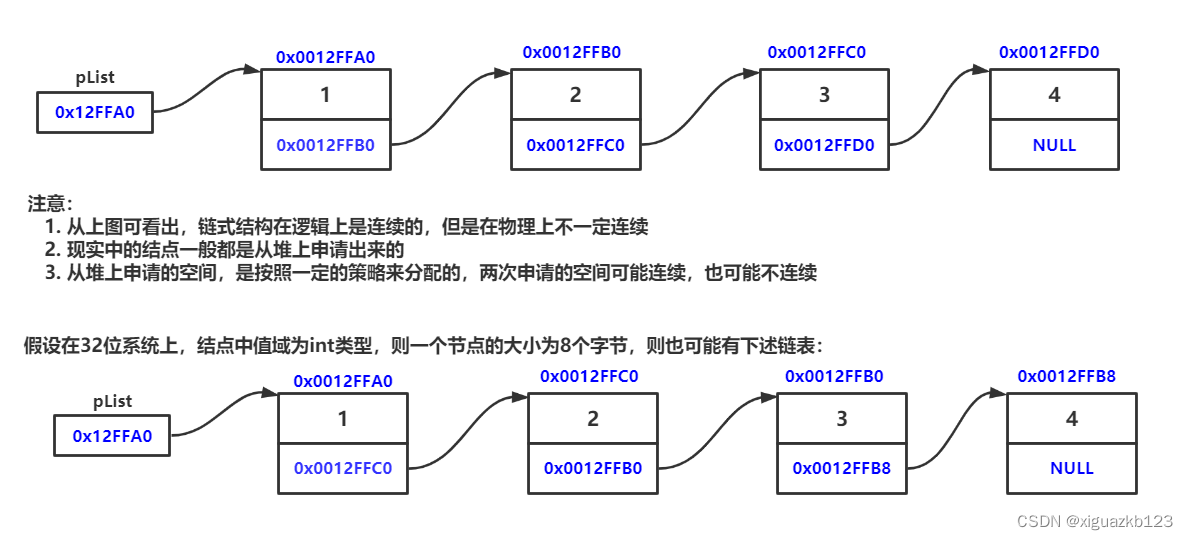 1.2链表的分类
1.2链表的分类
实际中链表的结构非常多样,以下情况组合起来就有8种链表结构:
1. 单向或者双向

2. 带头或者不带头

3. 循环或者非循环
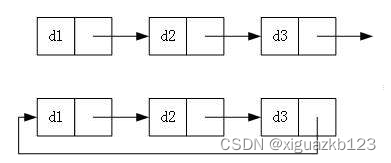
虽然有这么多的链表的结构,但是我们实际中最常用还是两种结构:
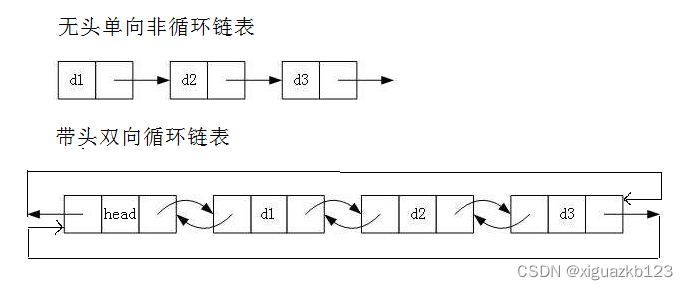
1. 无头单向非循环链表:结构简单,一般不会单独用来存数据。实际中更多是作为其他数据结构的子结构,如哈希桶、图的邻接表等等。另外这种结构在笔试面试中出现很多。
2. 带头双向循环链表:结构最复杂,一般用在单独存储数据。实际中使用的链表数据结构,都是带头双向循环链表。另外这个结构虽然结构复杂,但是使用代码实现以后会发现结构会带来很多优势,实现反而简单了,后面我们代码实现了就知道了。
2.链表的实现
#pragma once
#include <stdio.h>
#include <assert.h>
#include <stdlib.h>
//写入访问权限冲突 解决方法:#include <stdlib.h>
//无头+单向+非循环链表增删查改实现
typedef int SLTDateType;
typedef struct SListNode
{
SLTDateType data;//数据域--存储数据
struct SListNode* next;//指针域--存放下一个节点的地址
}SLTNode;
// 动态申请一个节点
SLTNode* BuyListNode(SLTDateType x);
// 单链表打印
void SListPrint(SLTNode* phead);
// 单链表尾插
void SListPushBack(SLTNode** pphead, SLTDateType x);
// 单链表的头插
void SListPushFront(SLTNode** pphead, SLTDateType x);
// 单链表的尾删
void SListPopBack(SLTNode** pphead);
// 单链表头删
void SListPopFront(SLTNode** pphead);
// 单链表查找
SLTNode* SListFind(SLTNode* phead, SLTDateType x);
//pos位置之前插入
void SListInsert(SLTNode**pphead, SLTNode* pos, SLTDateType x);
// 在pos的后面插入,这个更适合,也更简单
void SListInsertAfter(SLTNode* pos, SLTDateType x);
//单链表在pos位置上删除
void SListErase(SLTNode *pphead, SLTNode* pos);
//单链表在pos后面删除
void SListEraseAfter(SLTNode* pos)
//单链表的释放
void SListDestory(SLTNode** pphead);
2.1动态申请一个节点
SLTNode* BuyListNode(SLTDateType x)
{
SLTNode* newnode = (SLTNode*)malloc(sizeof(SLTNode));
if (newnode == NULL)
{
printf("malloc fail\n");
exit(-1);
}
newnode->data = x;
newnode->next = NULL;
return newnode;
}
2.2单链表打印
void SListPrint(SLTNode* phead)
{
SLTNode* cur = phead;
while (cur != NULL)
{
printf("%d->", cur->data);
cur = cur->next;
}
printf("NULL\n");
}2.3单链表尾插
void SListPushBack(SLTNode** pphead, SLTDateType x)
{
assert(pphead);
SLTNode* newnode = BuyListNode(x);
//判断是否为空结点
if (*pphead == NULL)
{
*pphead = newnode;//==*plist=newnode
}
else
{
//找到尾结点
SLTNode* tail = *pphead;
while (tail->next != NULL)
{
tail = tail->next;
}
tail->next = newnode;
}
}2.4单链表的头插
void SListPushFront(SLTNode** pphead, SLTDateType x)
{
assert(pphead);
SLTNode* newnode = BuyListNode(x);
//不用判空
newnode->next = *pphead;
*pphead = newnode;
}2.5单链表的尾删
void SListPopBack(SLTNode** pphead)
{
assert(pphead);
//判断是否空链表--非法访问
//a.温柔地方式
if (*pphead == NULL)
{
return;
}
//b.暴力地方式
///assert(*pphead != NULL);
//1.一个节点
//2.两个以上节点
if ((*pphead)->next == NULL)
{
free(*pphead);//释放pphead指向的
*pphead = NULL;
}
else
{
//方法一:
SLTNode* tail = *pphead;
SLTNode* prev = NULL;
while (tail->next/*tail->next != NULL*/)
{
prev = tail;
tail = tail->next;
}
free(tail);
tail = NULL;
prev->next = NULL;//一个节点非法访问
//方法二:
//SLTNode* tail = *pphead;
//while (tail->next->next)//一个节点非法访问
//{
// tail = tail->next;
//}
//free(tail->next);
//tail->next = NULL;
}
}2.6单链表头删
void SListPopFront(SLTNode** pphead)
{
assert(pphead);
//判断是否空链表--非法访问
//a.温柔地方式
if (*pphead == NULL)
{
return;
}
//b.暴力地方式
///assert(*pphead != NULL);
SLTNode* next = (*pphead)->next;
free(*pphead);
*pphead = next;
}2.7单链表查找
SLTNode* SListFind(SLTNode* phead, SLTDateType x)
{
SLTNode* cur = phead;
while (cur)
{
if (cur->data == x)
{
return cur;
}
else
{
cur = cur->next;
}
}
return NULL;
}2.8pos位置之前插入
void SListInsert(SLTNode** pphead, SLTNode* pos, SLTDateType x)
{
assert(pphead);
assert(pos);
SLTNode* newnode = BuyListNode(x);
if (*pphead == pos)
{
newnode->next = *pphead;
*pphead = newnode;
}
else
{
//找到pos的前一个位置
SLTNode* posPrev = *pphead;//pos为第一个节点时,posPrev找不到
while (posPrev->next != pos)
{
posPrev->next = newnode;
newnode->next = pos;
}
}
}2.9在pos的后面插入,这个更适合,也更简单
void SListInsertAfter(SLTNode* pos, SLTDateType x)
{
assert(pos);
//不改变*plist的指向,不用二级指针
//一级指针传参:可以修改它的内容 但不可以修改它的指向
//*pos指向一个节点
//可以修改它的内容data和next
//*plist里面是空的 没有data和next 无内容
//所以是通过二级指针来改变他指向的内容
//除非为*plist开辟空间 *plist成为一个空节点 成为一个哨兵位 就不需要二级指针
//直接通过next指向
assert(pos);
SLTNode* newnode = BuyListNode(x);
newnode->next = pos->next;
pos->next = newnode;
}
2.10单链表在pos位置上删除
void SListErase(SLTNode** pphead, SLTNode* pos)
{
assert(pphead);
assert(pos);
if (*pphead == pos)
{
*pphead = pos->next;
free(pos);
pos = NULL;
//SListPopFront(pphead);
}
else
{
SLTNode* prev = *pphead;
while(prev->next != pos)
{
prev = prev->next;
}
prev->next = pos->next;
free(pos);
pos = NULL;//置空与不置空都可以
//pos不置空也无所谓,毕竟在函数中是形参,形参的改变不会影响实参,处于好习惯,还是置空比较好
}
}2.11 单链表在pos后面删除
void SListEraseAfter(SLTNode* pos)
{
assert(pos);
assert(pos->next);
SLTNode* next = pos->next;
pos->next = next->next;
free(next);
next = NULL;
}2.12单链表的释放
void SListDestory(SLTNode** pphead)
{
assert(pphead);
SLTNode* cur = *pphead;
while (cur)
{
SLTNode* next = cur->next;
free(cur);
cur = next;
}
*pphead = NULL;
}
3.代码
SList.h
#pragma once
#include <stdio.h>
#include <assert.h>
#include <stdlib.h>
//写入访问权限冲突 解决方法:#include <stdlib.h>
//无头+单向+非循环链表增删查改实现
typedef int SLTDateType;
typedef struct SListNode
{
SLTDateType data;
struct SListNode* next;
}SLTNode;
// 动态申请一个节点
SLTNode* BuyListNode(SLTDateType x);
// 单链表打印
void SListPrint(SLTNode* phead);
// 单链表尾插
void SListPushBack(SLTNode** pphead, SLTDateType x);
// 单链表的头插
void SListPushFront(SLTNode** pphead, SLTDateType x);
// 单链表的尾删
void SListPopBack(SLTNode** pphead);
// 单链表头删
void SListPopFront(SLTNode** pphead);
// 单链表查找
SLTNode* SListFind(SLTNode* phead, SLTDateType x);
//pos位置之前插入
void SListInsert(SLTNode**pphead, SLTNode* pos, SLTDateType x);
// 在pos的后面插入,这个更适合,也更简单
void SListInsertAfter(SLTNode* pos, SLTDateType x);
//单链表在pos位置上删除
void SListErase(SLTNode *ppphead, SLTNode* pos);
//单链表在pos后面删除
void SListEraseAfter(SLTNode* pos)
//单链表的释放
void SListDestory(SLTNode** pphead);
SList.c
#define _CRT_SECURE_NO_WARNINGS 1
#include"SList.h"
void SListPrint(SLTNode* phead)
{
SLTNode* cur = phead;
while (cur != NULL)
{
printf("%d->", cur->data);
cur = cur->next;
}
printf("NULL\n");
}
SLTNode* BuyListNode(SLTDateType x)
{
SLTNode* newnode = (SLTNode*)malloc(sizeof(SLTNode));
if (newnode == NULL)
{
printf("malloc fail]\n");
exit(-1);
}
newnode->data = x;
newnode->next = NULL;
return newnode;
}
void SListPushBack(SLTNode** pphead, SLTDateType x)
{
assert(pphead);
SLTNode* newnode = BuyListNode(x);
//判断是否为空结点
if (*pphead == NULL)
{
*pphead = newnode;//==*plist=newnode
}
else
{
//找到尾结点
SLTNode* tail = *pphead;
while (tail->next != NULL)
{
tail = tail->next;
}
tail->next = newnode;
}
}
void SListPopBack(SLTNode** pphead)
{
assert(pphead);
//判断是否空链表--非法访问
//a.温柔地方式
if (*pphead == NULL)
{
return;
}
//b.暴力地方式
///assert(*pphead != NULL);
//1.一个节点
//2.两个以上节点
if ((*pphead)->next == NULL)
{
free(*pphead);//释放pphead指向的
*pphead = NULL;
}
else
{
//方法一:
SLTNode* tail = *pphead;
SLTNode* prev = NULL;
while (tail->next/*tail->next != NULL*/)
{
prev = tail;
tail = tail->next;
}
free(tail);
tail = NULL;
prev->next = NULL;//一个节点非法访问
//方法二:
//SLTNode* tail = *pphead;
//while (tail->next->next)//一个节点非法访问
//{
// tail = tail->next;
//}
//free(tail->next);
//tail->next = NULL;
}
}
void SListPushFront(SLTNode** pphead, SLTDateType x)
{
assert(pphead);
SLTNode* newnode = BuyListNode(x);
//不用判空
newnode->next = *pphead;
*pphead = newnode;
}
void SListPopFront(SLTNode** pphead)
{
assert(pphead);
//判断是否空链表--非法访问
//a.温柔地方式
if (*pphead == NULL)
{
return;
}
//b.暴力地方式
///assert(*pphead != NULL);
SLTNode* next = (*pphead)->next;
free(*pphead);
*pphead = next;
}
SLTNode* SListFind(SLTNode* phead, SLTDateType x)
{
SLTNode* cur = phead;
while (cur)
{
if (cur->data == x)
{
return cur;
}
else
{
cur = cur->next;
}
}
return NULL;
}
void SListInsert(SLTNode** pphead, SLTNode* pos, SLTDateType x)
{
assert(pphead);
assert(pos);
SLTNode* newnode = BuyListNode(x);
if (*pphead == pos)
{
newnode->next = *pphead;
*pphead = newnode;
}
else
{
//找到pos的前一个位置
SLTNode* posPrev = *pphead;//pos为第一个节点时,posPrev找不到
while (posPrev->next != pos)
{
posPrev->next = newnode;
newnode->next = pos;
}
}
}
// 在pos的后面插入,这个更适合,也更简单
void SListInsertAfter(SLTNode* pos, SLTDateType x)
{
assert(pos);
//不改变*plist的指向,不用二级指针
//一级指针传参:可以修改它的内容 但不可以修改它的指向
//*pos指向一个节点
//可以修改它的内容data和next
//*plist里面是空的 没有data和next 无内容 所以是通过二级指针来改变他指向的内容
//除非为*plist开辟空间 *plist成为一个空节点 成为一个哨兵位 就不需要二级指针 直接通过next指向
assert(pos);
SLTNode* newnode = BuyListNode(x);
newnode->next = pos->next;
pos->next = newnode;
}
void SListErase(SLTNode** pphead, SLTNode* pos)
{
assert(pphead);
assert(pos);
if (*pphead == pos)
{
*pphead = pos->next;
free(pos);
pos = NULL;
//SListPopFront(pphead);
}
else
{
SLTNode* prev = *pphead;
while(prev->next != pos)
{
prev = prev->next;
}
prev->next = pos->next;
free(pos);
pos = NULL;//置空与不置空都可以
//pos不置空也无所谓,毕竟在函数中是形参,形参的改变不会影响实参,处于好习惯,还是置空比较好
}
}
void SListEraseAfter(SLTNode* pos)
{
assert(pos);
assert(pos->next);
SLTNode* next = pos->next;
pos->next = next->next;
free(next);
next = NULL;
}
void SListDestory(SLTNode** pphead)
{
assert(pphead);
SLTNode* cur = *pphead;
while (cur)
{
SLTNode* next = cur->next;
free(cur);
cur = next;
}
*pphead = NULL;
}
Test.c
#define _CRT_SECURE_NO_WARNINGS 1
#include"SList.h"
void test()
{
SLTNode* plist = NULL;
//*plist指向的是NULL
SListPushBack(&plist, 1);
SListPushBack(&plist, 1);
SListPushBack(&plist, 1);
SListPushBack(&plist, 1);
SListPrint(plist);
SListPushFront(&plist, 2);
SListPushFront(&plist, 2);
SListPushFront(&plist, 2);
SListPushFront(&plist, 2);
SListPushFront(&plist, 2);
SListPrint(plist);
SListPopBack(&plist);
SListPopBack(&plist);
SListPrint(plist);
SListPopFront(&plist);
SListPopFront(&plist);
SListPopFront(&plist);
SListPrint(plist);
SLTNode* pos = SListFind(plist, 2);
int i = 1;
while (pos)
{
printf("第%d个pos节点:%->%d\n", i++, pos, pos->data);
pos = SListFind(pos->next, 2);
}
//修改值 2-20
pos = SListFind(plist, 2);
if (pos)
{
pos->data = 20;
}
SListPrint(plist);
pos = SListFind(plist, 20);
if (pos)
{
pos->data = 30;
}
SListPrint(plist);
pos = SListFind(plist, 3);
if (pos)
{
SListInsert(&plist, pos, 30);
}
SListPrint(plist);
pos = SListFind(plist, 30);
if (pos)
{
SListInsert(&plist, pos, 300);
}
SListPrint(plist);
pos = SListFind(plist, 300);
if (pos)
{
SListInsertAfter(pos, 3000);
}
SListPrint(plist);
pos = SListFind(plist, 3000);
if (pos)
{
SListErase(&plist, pos);
}
SListPrint(plist);
pos = SListFind(plist, 300);
if (pos)
{
SListEraseAfter(pos);
}
SListPrint(plist);
SListDestory(&plist);
}
int main()
{
test();
return 0;
}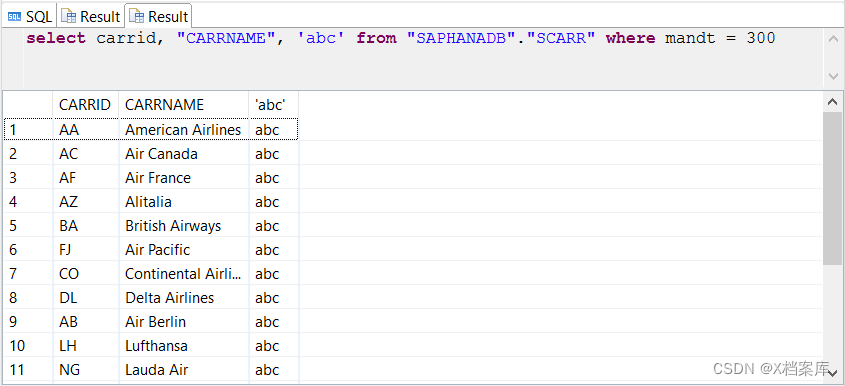
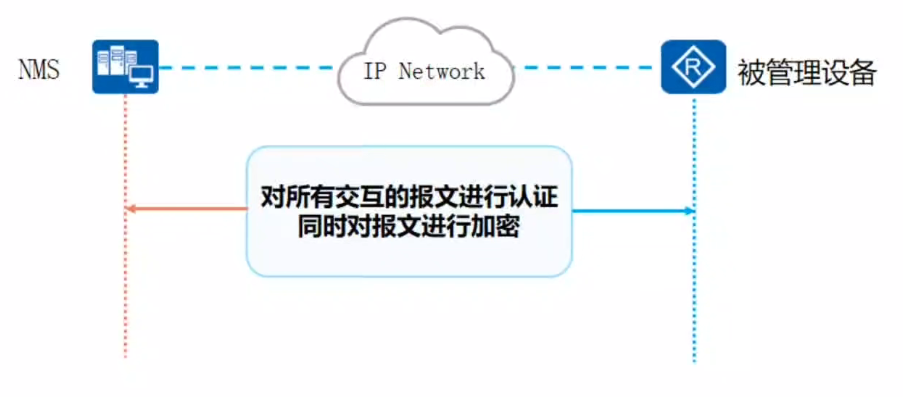
![[leetcode.29]两数相除,位运算虽好,不要满眼是她](https://img-blog.csdnimg.cn/fcea493452824a338527b027965da147.png)
